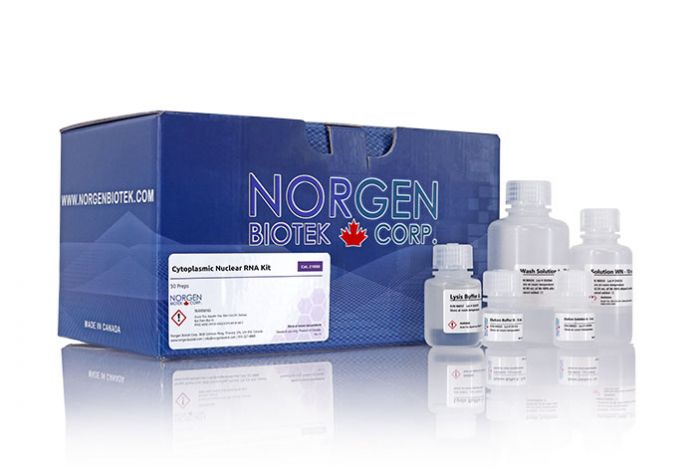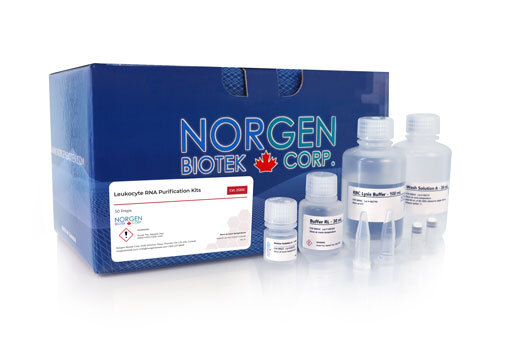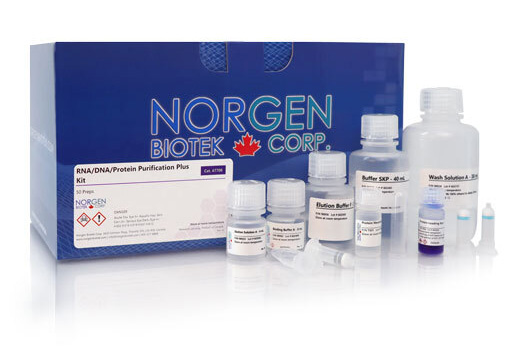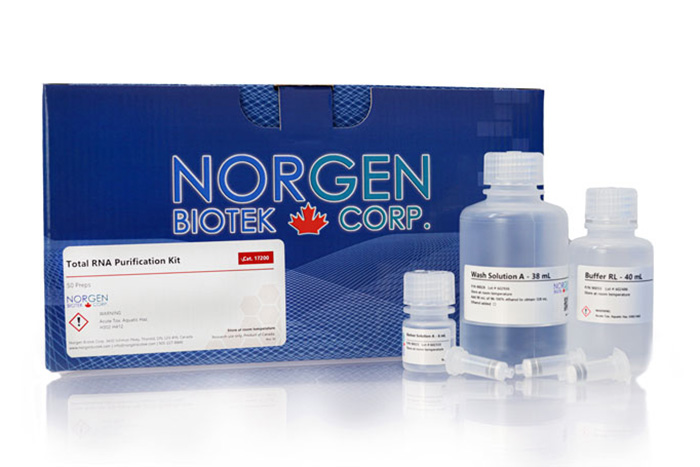microRNA Purification Kit

For research use only and NOT intended for in vitro diagnostics.
microRNA Purification Kit
Register today to receive an exclusive 15% off* on your first order.
Supporting Data
Figure 1. High Quality of Isolated RNA with Better Size Exclusion. Small RNA was isolated from HeLa cells using Norgen's microRNA Purification Kit (Lanes C and D) and a competitor's kit (Lanes A and B). Ten microliters of the 50 µL purified small RNA were run on an 8% urea-agarose gel. Lane M is Norgen's 100b RNA ladder. Note that Norgen's kit is isolating only the small (<200 nt) RNA species, with no contaminating larger RNA.
Figure 2. Efficient Removal of Large RNA Species. Different RNA species were isolated from 106 HeLa cells, resolved on an Agilent® Lab-On-A-Chip, and electropherograms were generated. Panel A contains all the RNA species present in 106 HeLa cells as isolated with Norgen's Total RNA Purification Kit and acts as a control. Panel B and C contain RNA that was isolated from 106 HeLa cells using Norgen’s microRNA Purification Kit. One microliter of the 50 µL purified RNA for each fraction was loaded. Panel B shows the large RNA species removed using the Large RNA Removal Columns, and no small RNA can be detected. Panel C shows the small RNA that is isolated using the microRNA Enrichment Columns and shows that there is no contamination of the small RNA with any large RNA species above 200 nt. This demonstrates the effective separation of the small RNA from the large RNA species using Norgen's microRNA Purification Kit.
Figure 3. Effective Small RNA Amplification by End-Point RT-PCR. Norgen's microRNA Purification Kit isolates small RNA that could be amplified in RT-PCR using the poly (A) polymerase extension method. Small RNA was isolated from 1 million HeLa cells, and 10 µL of the 20 µL isolated small RNA were polyadenylated in a 50 µL Poly-(A)-Polymerase reaction. Seven microliters of the polyadenylated RNA were used in a 20 µL reverse transcription reaction with a poly T adaptor primer. One microliter of the reverse transcription was used in a 20 µL PCR reaction with primers against the human microRNAs (miR-21) and 5S rRNA. Panel A shows the amplification of the miR-21 transcript from small RNAs while Panel B shows the 5S rRNA amplification from small RNAs. Lane 1 in both panels shows the results when total RNA isolated from 1 million HeLa cells using Norgen's Total RNA Purification Kit was used as a control. Lanes 2 and 3 contain the successful RT-PCR when the microRNA isolated using Norgen's microRNA Purification Kit was used as the template, and Lanes 4 contain the non-template control. The RT-PCR was successful for both reactions using the microRNA as the template. All PCR products were resolved on a 1X TAE, 3% agarose gel using Norgen's PCR Ranger as the molecular weight ladder.
Figure 4. Better Recovery of miRNAs by Norgen's microRNA Purification Kit. Norgen's microRNA Purification Kit recovers microRNA more effectively than its competitors. Small RNA was isolated from 0.75 million HeLa cells using Norgen's microRNA Purification Kit and a competitors' kits. Relative expression of (A) miR-21, (B) miR-19, and (C) 5S rRNA was determined by RT-qPCR of polyadenylated total RNA samples. RT-qPCR was performed according to Shi and Chiang (2005). Fifteen microliters of the 50 µL isolated RNA were polyadenylated in a 50 µL Poly-(A)-Polymerase reaction. Four microliters of the polyadenylated RNA were used in a 20 µL reverse transcription reaction with a poly T adaptor primer. One microliter of the reverse transcription was then used in a 20 µL qPCR reaction with primers against the human microRNAs (miR-19 and miR-21) and house-keeping small RNA (5S rRNA). The resulting threshold cycle (Ct) values were summarized in the graph. Blue = Norgen's microRNA Purification Kit; orange = Silica-based Competitor micro-RNA Kit; green = Silica-based Competitor Total RNA Kit; red = Phenol-based reagent protocol; yellow = No Template Control. Norgen's microRNA Purification Kit recovered more miRNAs (lower Ct) than the competitor's microRNA-specific Kit.
|
Kit Specifications
|
|
|
Maximum Column Binding Capacity
|
Up to 50 μg RNA
|
|
Maximum Column Loading Volume
|
650 μL
|
| Minimum Elution Volume | 20 μL |
| Size of RNA Purified |
All sizes, including small RNA < 200 nt
|
| Time to Complete 10 Purifications |
25 minutes
|
| Maximum Amount of Starting Material: Animal Cells Animal Tissues Bacteria Plant Tissues Blood |
3 x 106 cells 5-25 mg 1 x 109 cells 50 mg 100 μL |
Storage Conditions and Product Stability
All solutions should be kept tightly sealed and stored at room temperature. This kit is stable for 1 year after the date of shipment.
| Component | Cat. 21300 (25 preps) |
|---|---|
| Buffer RL | 40 mL |
| Wash Solution A | 38 mL |
| Elution Solution A | 6 mL |
| Large RNA Removal Column | 25 |
| microRNA Enrichment Column | 25 |
| Collection Tube | 50 |
| Elution Tubes (1.7 mL) | 50 |
| Product Insert | 1 |
Documentation
FAQs
Poor RNA recovery could be due to one or more of the following:
- Incomplete lysis of cells or tissue. Ensure that the appropriate amount of Buffer RL was used for the amount of cells or tissue.
- Large RNA Removal Column has become clogged. Do not exceed the recommended amounts of starting materials. The amount of starting material may need to be decreased if the column shows clogging below the recommended levels. See FAQ related to “Clogged Column” below.
- An alternative elution solution was used. It is recommended that the Elution Solution A supplied with this kit be used for maximum RNA recovery.
- Low RNA content. Different tissues and cells have different RNA contents. Some tissues may not contain small RNA at detectable levels when processing the small sample sizes required for this procedure.
- Flowthrough from the first binding step was discarded. The flowthrough from the binding step with the Large RNA Removal Column contains the small RNA molecules, thus ensure that it is not inadvertently discarded.
- Ethanol was not added to the flowthrough before binding to the microRNA Enrichment Column. Ensure that the appropriate amount of ethanol was added to the flowthrough from the first binding step before it is applied to the microRNA Enrichment Column. This is imperative in order to capture the small RNA molecules.
- Ethanol was not added to the Wash Solution A. Ensure that 90 mL of 96 – 100% ethanol is added to the supplied Wash Solution A prior to use.
- Cell Culture: Cell monolayer was not washed with PBS. Ensure that the cell monolayer is washed with the appropriate amount of PBS in order to remove residual media from cells.
- Bacteria: All traces of media not removed. Ensure that all media is removed prior to the addition of the Buffer RL through aspiration.
Column clogging can result from one or a combination of the following factors:
- Insufficient solubilization of cells or tissues. Ensure that the appropriate amount of Lysis Buffer was used for the amount of cells or tissue.
- Maximum number of cells or amount of tissue exceeds kit specifications. Refer to specifications to determine if the amount of starting material falls within kit specifications.
- High amounts of genomic DNA present in sample. The lysate may be passed through a 25 gauge needle attached to a syringe 5-10 times in order to shear the genomic DNA prior to loading onto the Large RNA Removal Column.
- Centrifuge temperature is too low. Ensure that the centrifuge remains at room temperature throughout the procedure. Temperatures below 15°C may cause precipitates to form that can cause the columns to clog.
RNA can be degraded due to the following factors:
- RNase contamination. RNases may be introduced during the use of the kit. Ensure proper procedures are followed when working with RNA. Please refer to “Working with RNA” at the beginning of this user guide.
- Procedure not performed quickly enough. In order to maintain the integrity of the RNA, it is important that the procedure be performed quickly. This is especially important for the Cell Lysate Preparation Step in the Animal Tissue protocol, since the RNA in animal tissues is not protected after harvesting until it is disrupted and homogenized.
- Improper storage of the purified RNA. For short term storage, RNA samples may be stored at –20°C for a few days. It is recommended that samples be stored at –70°C for longer term storage.
- Frozen tissues or pellets were allowed to thaw prior to disruption. Tissue samples should be flash-frozen in liquid nitrogen and transferred immediately to a -70°C freezer for long term storage. Do not allow frozen tissues to thaw prior to grinding with the mortar and pestle in order to ensure that the integrity of the RNA is not compromised.
If the RNA does not perform well in downstream applications, it may be due to one or more of the following:
- RNA was not washed 3 times with the provided Wash Solution A. Traces of salt from the binding step may remain in the sample if the well is not washed 3 times with Wash Solution A. Salt may interfere with downstream applications, and thus must be washed from the well.
- Ethanol carryover. Ensure that the dry spin under Column Wash in the centrifugation protocol or the extended vacuum in the vacuum protocol is performed in order to remove traces of ethanol prior to elution. Ethanol is known to interfere with many downstream applications.
The contamination with genomic DNA may be due to large amount of starting material used. Perform RNase-free DNase I digestion on the RNA sample after elution to remove genomic DNA contamination. It is recommended that Norgen’s RNase-Free DNase I Kit (Product # 25710) be used for this step.
Large RNA species may be present in the elution due to:
- Improper amount of ethanol added to the lysate before binding to the Large RNA Removal Column. Ensure that the appropriate amount of ethanol was added to the lysate before it is applied to the Large RNA Removal Column. This is imperative in order to capture the large RNA molecules onto the column.
- Large amount of starting material used. Repeat purification using less starting material. Alternatively, the isolation procedure can be repeated using the elution as the input. The elution volume should first be adjusted to 300 µL using the provided Buffer RL. The procedure can then be followed as written in the manual, starting with the addition of ethanol, centrifuging the lysate in order to pellet any debris, and applying the clarified lysate to the Large RNA Removal Column. Repeating the procedure should result in the removal of the large, contaminating RNA species.
Although it is recommended to use fresh non-coagulating (EDTA) blood for RNA purification, frozen blood samples can also be processed. Please thaw the frozen blood samples on ice for 15 minutes, and then at room temperature (21 degrees) for 10 minutes before proceeding to the kit protocol. Please note that frozen blood samples are known to yield more degraded RNA compared to fresh blood samples.




